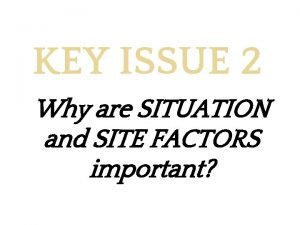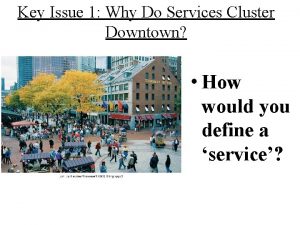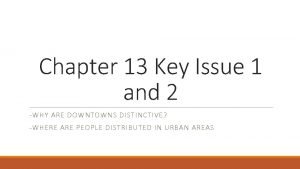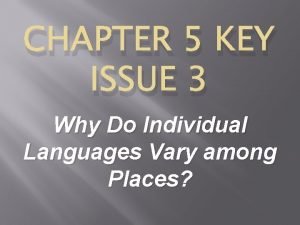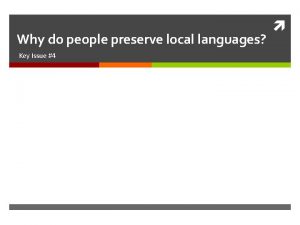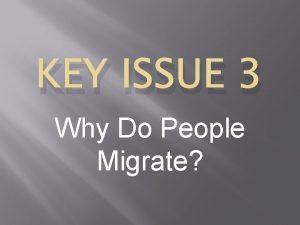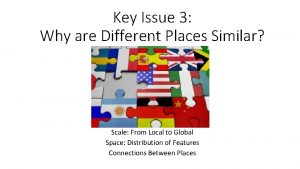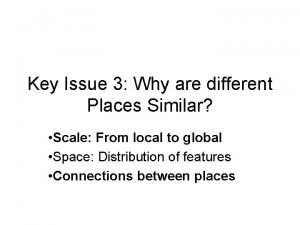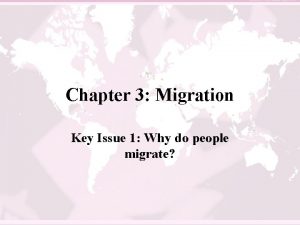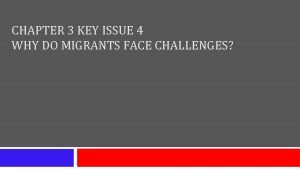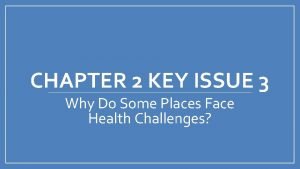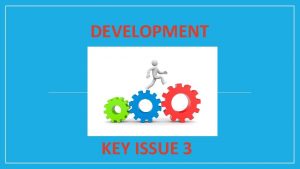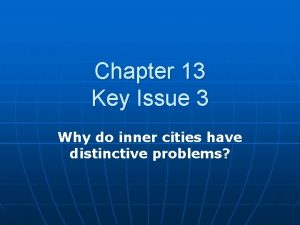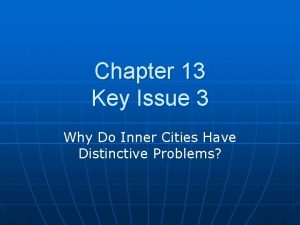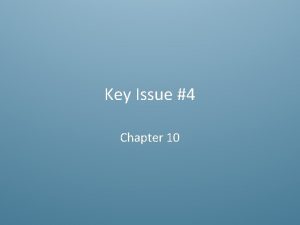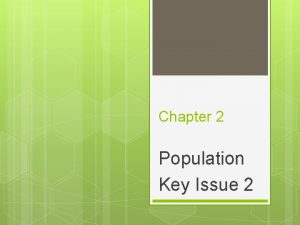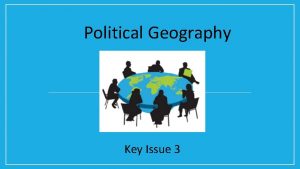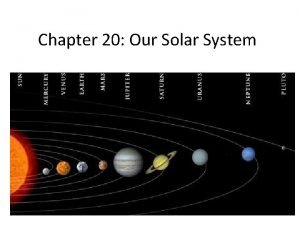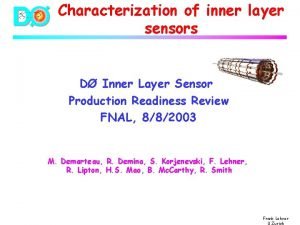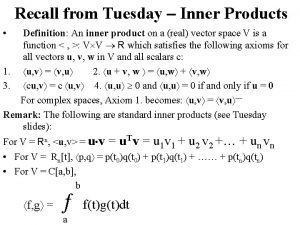Chapter 13 Key Issue 4 Why do inner















- Slides: 15

Chapter 13 Key Issue 4 Why do inner suburbs have distinctive problems?

Problems of Suburbs • The peripheral model – Density gradient – Cost of suburban sprawl – Suburban segregation • Transportation and suburbanization – Motor vehicles – Public transportation • Local government fragmentation – Metropolitan government – Growing smart

Growth of Chicago Fig. 13 -19: Chicago grew rapidly in the 19 th century through annexation. In the 20 th century the major annexation was for O’Hare Airport. The city of Chicago covers only a portion of the Chicago metropolitan statistical area (inset).

The Peripheral Model n n n An increasing % of people are living in the suburbs. Suburbs offer: houses, private land surrounding the house, space for cars, opportunity for house ownership, space and privacy. Families are attracted to suburbs because of space to play and protection from crime & traffic. Chauncey Harris says the U. S. follows the peripheral model: an urban area that has an inner city surrounded by suburban residential and business areas, tied by a road. Peripheral areas lack major physical, social and economic problems of inner-city neighborhoods. Around the ring road are edge cities with consumer and business services, manufacturing centers, hotels and even theme park attractions.

Peripheral Model of Urban Areas Fig. 13 -20: The central city is surrounded by a ring road, around which are suburban areas and edge cities, shopping malls, office parks, industrial areas, and service complexes.

Cleveland, Ohio Density Gradient 1900 -1990 Fig. 13 -21: The density gradient in Cleveland shows the expansion of dense population outward from the city center over time. In 1990, population dispersed over a wider area with less variation in density than before.

Density Gradient n n n Traveling outward from the center of a city, population density declines, known as density gradient. The number of houses per unit of land decreases as distance from the city center increases. Changes in density gradient: 1)# of people living in the center has decreased, providing a gap in the center 2) # of people living on a hectacre of land has decreased in the central residential areas because of population decrease and the spread of suburbs. Sprawl is the continual spread of development over the landscape. Developers seek cheap land that can easily be developed and sprawl happens from families wanting to own larger areas of land.

Suburban Development n n n n If there continues to be demand for single-family detached houses then suburbs will continue. Current system of developing land on urban peripheries is inefficient in the U. S. Developers buy farms, often farther away from the city, creating open pockets between cities and suburbs. New roads and utilities must be constructed, costing tax payers. Land is wasted as prime agricultural land is lost to housing developments. Energy is wasted due to more commuters Greenbelts or rings of open space are used to surround some cities. Residential suburbs are segregated: residents are separated from commercial and manufacturing activities of the cities and housing is usually built for people that can afford the cost of living. Zoning ordinances prevented the mixing of land uses in the same district residential and commercial are usually separate.

Suburban Development in the U. S. and U. K. Fig. 13 -22: New housing in the U. K. is likely to be in planned new towns, while in the U. S. growth occurs in discontinuous developments.

Northampton, United Kingdom There is usually a sharp boundary between an urban area in the U. K. , such as Northampton, and the surrounding rural area.

Transportation n n n People are more dependent on transportation for access to work, shopping and leisure in suburbs. More than half the trips are work-related, 1/4 th of trips are shopping or personal trips. Cars are an important user of land in the city as an average city provides 1/4 th of its land to roads and parking lots. Technological improvements have helped traffic flow with GPS, congestion charges, toll roads. Rush hour is the peak hour of four consecutive 15 -minute periods that have the heaviest traffic. Average American loses 36 hours per year sitting in traffic jams and wastes 55 gallons of gas, valuing more than $1 billion per year in the U. S. Many cities have built rapid transit lines to provide faster, cheap transportation.

Tokyo Subway “Subway pushers” help push as many people as possible into subway cars during rush hour in Tokyo. Other passengers wait in orderly lines to board the next train.

Public Transport in Brussels Fig. 13 -23: Brussels, Belgium illustrates the integration of heavy rail (Métro Lines 1 & 2) and light rail (trams) in European public transport.

Tram Line in Brussels A Line 92 tram on the Rue Royale in Brussels.

Fragmentation of Local Governments n n n The fragmenting of local governments in the U. S. makes it difficult to solve regional problems of traffic, waste disposal and building affordable housing. Firefighters for example are often summoned from multiple stations to attend to the same response because of overlapping districts. The large # of local government units has called for a metropolitan government that could coordinate all the local governments. A council of government is a cooperative agency of representatives of various local governments in the region. Some are known as federations and others as consolidations. Smart growth is legislation and regulations to limit suburban sprawl and preserve farmland.
 Inner defender examples
Inner defender examples Hey bye bye
Hey bye bye Inner critic and inner defender
Inner critic and inner defender Key issue 2 why are situation and site factors important
Key issue 2 why are situation and site factors important Why do services cluster downtown
Why do services cluster downtown Key issue 1 why are downtowns distinctive
Key issue 1 why are downtowns distinctive Key issue 4 why do countries face obstacles to development
Key issue 4 why do countries face obstacles to development Key issue 3: why do individual languages vary among places?
Key issue 3: why do individual languages vary among places? Languages
Languages Dubai 1985
Dubai 1985 Why are places similar
Why are places similar Key issue 3 why are different places similar
Key issue 3 why are different places similar Key issue 3: why do people migrate?
Key issue 3: why do people migrate? Key issue 4 why do migrants face obstacles
Key issue 4 why do migrants face obstacles Key issue 4 why do migrants face obstacles
Key issue 4 why do migrants face obstacles Chapter 2 population and health key issue 3
Chapter 2 population and health key issue 3



